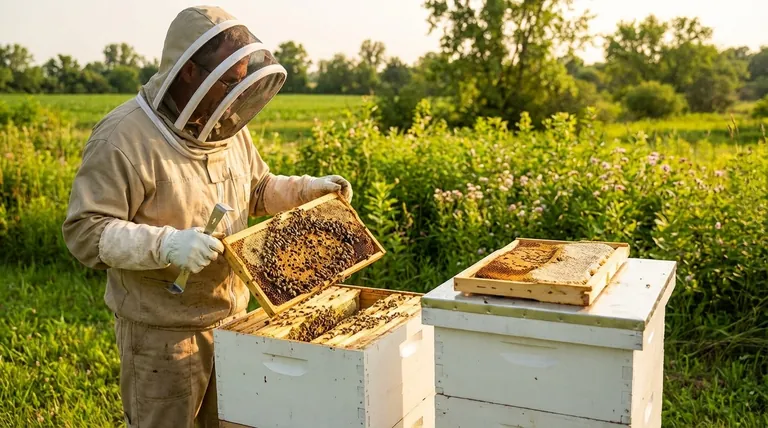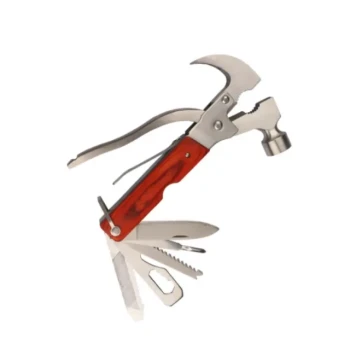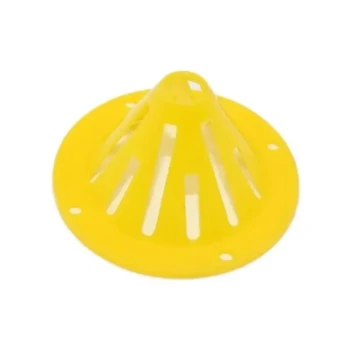Comparing your hives is not a competition; it is one of the most powerful diagnostic tools a beekeeper possesses. This practice provides a crucial baseline to evaluate a colony's health, productivity, and genetic potential, allowing you to spot problems before they become catastrophic failures.
By establishing a yard-wide average from all your hives, you can instantly identify which colonies are thriving and which are falling behind. This transforms your beekeeping from a series of isolated guesses into a data-driven practice, giving you a clear signal on where to focus your attention.

Establishing Your Apiary's Baseline
To understand any single hive, you must first understand what is "normal" for your specific location and time of year. Comparison is the only way to establish this critical context.
The Power of a "Local Normal"
A single hive is just one data point. Without others to compare it to, you have no way of knowing if its progress is good, average, or poor.
Multiple hives in the same apiary create a "local normal." This average becomes your benchmark for performance.
Accounting for Shared Conditions
All hives in the same yard experience the same weather, forage availability (nectar flow), and regional pest pressure.
Because these external variables are constant, significant differences between hives are almost always due to internal factors, such as the queen's quality or the colony's health.
Key Indicators for Comparison
During an inspection, certain metrics provide the clearest insight when compared from one hive to the next. A consistent evaluation process is key.
Brood Pattern and Population
Look at the size and density of the brood nest. A strong queen in a healthy hive will lay in a solid, compact pattern with few empty cells.
A spotty, shotgun-like brood pattern or a noticeably smaller population compared to neighboring hives is a major red flag for a failing queen or a disease issue.
Resource Collection (Honey and Pollen)
Evaluate how quickly your hives are building up their food stores. While some variation is normal, one hive that is nearly empty while others are packing away nectar points to a problem.
A colony lagging in stores may have a low forager population, be suffering from disease, or be the victim of robbing by stronger colonies.
Temperament and Behavior
Genetics play a massive role in a colony's disposition. Note any major differences in defensiveness during inspections.
Comparing temperament helps you identify gentle genetics worth propagating and aggressive colonies that may need to be requeened.
Uncovering Problems Through Comparison
The primary benefit of comparison is early problem detection. An outlier hive that deviates significantly from the apiary average is signaling for your help.
Identifying Queen Issues
The most common cause for an underperforming hive is a weak or failing queen. Her genetics and egg-laying capacity dictate the colony's potential.
If one hive is lagging in population growth while the others are booming under the same nectar flow, the queen is your first and most likely suspect.
Spotting Disease and Pests
Some colonies are genetically better at managing pests like Varroa mites through hygienic behavior.
A hive with a high mite count or signs of disease (like Chalkbrood or Sacbrood) when others in the yard are clean indicates poor genetics or a compromised collective immune system.
The Nuance of Genetic Variation
It is crucial to remember that not all differences signal a problem. Sometimes, you are simply observing the expression of different, but equally valid, genetic strategies.
Not Every Difference Is a Defect
Some bee stocks are bred to build up their population explosively in early spring to catch the first nectar flow.
Others may build up more slowly but are more frugal with their winter stores. Understanding these traits prevents you from misinterpreting a genetic strategy as a flaw.
Improving Your Stock
Comparison is your best tool for apiary improvement. By observing your hives over a season, you can definitively identify your top performers.
These are the hives that are not only productive but also gentle, disease-resistant, and well-suited to your specific climate. They are the ideal candidates from which to raise new queens, improving the overall quality of your bees.
Making Data-Driven Decisions
Use your comparative observations to take decisive action that strengthens your entire apiary. Your goal is to support the weak and learn from the strong.
- If your primary focus is identifying problems: Look for the outlier—the hive that is significantly behind the yard average in population, brood, or stores.
- If your primary focus is improving genetics: Identify your top-performing hive in terms of temperament, productivity, and health to use for future queen rearing.
- If you are a new beekeeper: Focus on simply understanding what a "normal" progression looks like for your area by comparing your first few hives.
By treating your apiary as a single, interconnected system, you move from simply keeping bees to truly managing them.
Summary Table:
| Key Indicator | What to Compare | What It Reveals |
|---|---|---|
| Brood Pattern | Size, density, and consistency of brood nest | Queen quality or potential disease |
| Resource Collection | Honey and pollen stores compared to neighbors | Forager population, robbing, or health issues |
| Temperament | Defensiveness during inspections | Genetic disposition; identifies gentle or aggressive colonies |
| Population Growth | Rate of build-up relative to other hives | Queen performance or genetic strategy |
Upgrade Your Apiary Management with HONESTBEE
As a commercial apiary or beekeeping equipment distributor, you understand the value of data-driven decisions. HONESTBEE supplies the durable, precision beekeeping supplies and equipment you need to efficiently monitor and compare your hives. From durable hive tools to advanced monitoring systems, our wholesale-focused operations ensure you get reliable gear that stands up to commercial use.
Ready to strengthen your beekeeping practice? Contact HONESTBEE today to discuss your equipment needs and elevate your apiary's performance.
Visual Guide

Related Products
- HONESTBEE Advanced Ergonomic Stainless Steel Hive Tool for Beekeeping
- HONESTBEE 15-in-1 Beekeeper Multi-Tool with Hammer and Pliers for Beekeeping
- Professional Galvanized Hive Strap with Secure Locking Buckle for Beekeeping
- Professional Engraved Round Hive Number Tags for Beekeeping
- Versatile Ratchet Hive Strap with S-Hooks for Secure Fastening
People Also Ask
- What is the hole in a hive tool for? A Multi-Tool for Apiary Repairs and Maintenance
- What tools are used for cleaning frames? A Beekeeper's Simple 4-Tool Guide
- What are the features of a regular hive tool? The Essential Multi-Tool for Every Beekeeper
- Why do hive tools have a hole? Unlock the Secret to Efficient Beekeeping
- How is a hive tool used for scraping and cleaning? Master Hive Maintenance for a Healthy Colony



















